About Azolla
- Azolla is a aquatic floating fern which resembles as algae.
- The fern appears as a green mat over water.
- Normally azolla is grown in paddy fields or shallow water bodies.
- Azolla multiplies very rapidly.
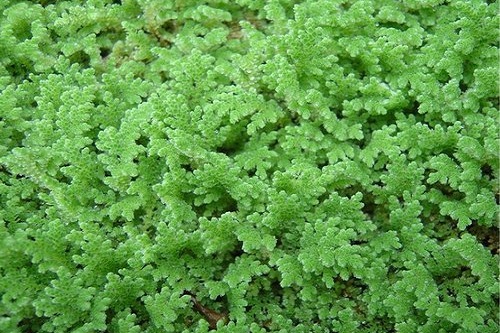
Azolla as fodder/ feed
- Rich in proteins, essential amino acids, vitamins (vitamin A, vitamin B12 and Beta- Carotene), growth promoter intermediaries and minerals like calcium, phosphorous, potassium, ferrous, copper, magnesium
- Dry weight basis, it contains 25 – 35 percent protein, 10 – 15 percent minerals and 7 – 10 percent of amino acids, bio-active substances and bio-polymers.
- Livestock easily digest it, owing to its high protein and low lignin content.
- Azolla can be mixed with concentrates or can be given directly to livestock
- Can also be fed to poultry, sheep, goats, pigs and rabbits.
Nutrition wise comparison of Azolla with other fodder
|
S.No |
Item | Annual production of biomass (MT/ha) | Dry matter content (MT/ha) |
Protein content (%) |
|
1 |
Hybrid Napier |
250 |
50 |
4 |
|
2 |
Kolakattao grass |
40 |
8 |
0.8 |
|
3 |
Lucerne |
80 |
16 |
3.2 |
|
4 |
Cowpea |
35 |
7 |
1.4 |
|
5 |
Subabool |
80 |
16 |
3.2 |
|
6 |
Sorghum |
40 |
3.2 |
0.6 |
|
7 |
Azolla |
1,000 |
80 | 24 |
Azolla Production
- The soil in the area is first cleared of weeds and leveled.
- Bricks are lined horizontally in a rectangular fashion.
- A UV stabilized silpauline sheet of 2mX2m size is uniformly spread over the bricks in such a way as to cover the margin of the rectangle made by the bricks.
- 10cm standing water are maintained in pit.
- 10-15 kg of sieved soil, 2 kg cow dung slurry and 30 g of Super Phosphate mixed in 10 liters of water, is mixed in water in pit.
- About 0.5-1kg of pure azolla culture seed is spread uniformly over the water, after mild stirring of soil and water in the azolla bed.
- Fresh water should be sprinkled over the azolla immediately after inoculation to make the azolla plants upright.
- In a week’s time, the azolla spreads all over the bed and develops a thick mat like appearance.
- A mixture of 20 g of Super Phosphate and about 1 kg of cow dung should be added once in 5 days in order to maintain rapid multiplication.
- A micronutrient mix containing magnesium, iron, copper, sulphur etc., can also be added at weekly intervals to enhance the mineral content of azolla.
- About 5 kg of bed soil should be replaced with fresh soil, once in 30 days, to avoid nitrogen build up and prevent micro-nutrient deficiency.
- 25 to 30 percent of the water also needs to be replaced with fresh water, once every 10 days, to prevent nitrogen build up in the bed.
- The bed should be cleaned, the water and soil replaced and new azolla inoculated once every six months.
- A fresh bed has to be prepared and inoculated with pure culture of azolla, when contaminated by pest and diseases.
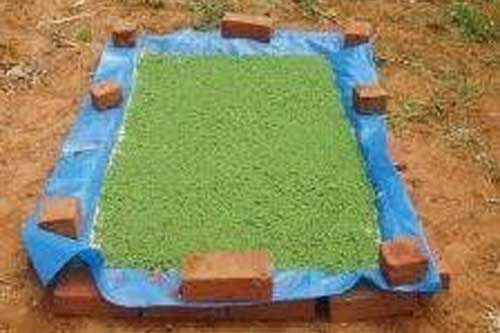
Harvesting
- Will grow rapidly and fill the pit within 10 – 15 From then on, 500 – 600 g of azolla can be harvested daily.
- Can be done every day from the15th day onwards with the help of a plastic sieve or tray with holes at the bottom.
- The harvested azolla should be washed in fresh water to get rid of the cow dung smell.
Alternative Inputs
- Fresh biogas slurry may also be used.
- Waste water from bathroom and cattle shed can also be used to fill the pit. In areas where there is a problem of fresh water availability, the water left after washing clothes (after the second rinsing) can also be used.
Environmental factors for the growth
- Temperature 20°C – 28°C
- Light 50% full sunlight
- Relative Humidity 65 – 80%
- Water (standing in the tank) 5 – 12 cm
- pH 4-7.5
Points to be noted during cultivation of azolla
- Washing in a net will be useful as it will allow small plantlets to get out, and they can be poured back in to the pond.
- Care should be taken to retain the temperature below 25°
- Shade nets can be used to cut the light intensity.
- The azolla biomass should be removed daily to avoid over crowding.
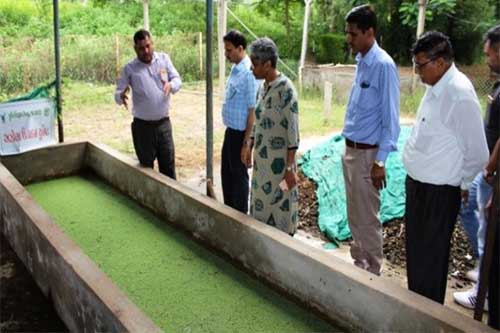
Precaution to be adopted
- Maintenance of pure culture free from contamination is essential for good yield.
- Azolla should be harvested regularly to avoid overcrowding.
- Temperature is an important factor for good growth. It should be around 35 degrees Celsius. The fodder plot is to be covered with a plastic sheet in cold regions so as to reduce the impact of cold weather.


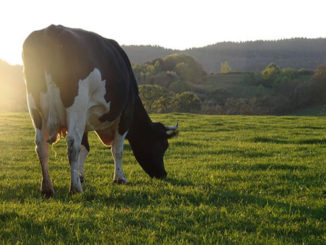

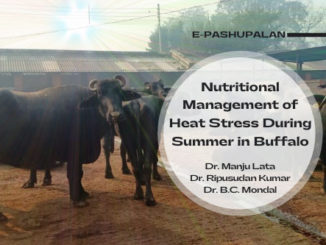

1 Trackback / Pingback